Retro Review: Dario Argento’s Giallo Masterpiece ‘Tenebrae’
Italian filmmaker Dario Argento has had quite the unique career. Beginning in 1970, he started making giallos with Bird with the Crystal Plumage. In 1975, his Deep Red really got him noticed internationally. His stylish way of staging murders was perfect for the time (post-60s/early 70s).
In 1976, he blew the world’s collective mind with his unqualified chef d’ouvre, Suspiria. Determined to complete his “Mothers” trilogy after such a trimphant success, he followed up with the so-so Inferno in 1980. He must have been offended by the chilly reception it received, so he decided to kick atmospheric horror to the curb and go back to…giallo.
And what a smart decision it was. 1982’s Tenebrae is hands-down the best giallo there ever was. It’s got the leather glove-covered hands, scenes of suspense that get the audience so tensed up that it’s time to explode. And lotsa gore! The red stuff positively rains down!
 Anthony Franciosa stars as Peter O’Neal, an American crime writer who arrives in Rome as part of his international book tour. A rash of murders have recently been committed that seem eerily close to the killings he’s described in his latest novel, and the police think he’s the next target.
Anthony Franciosa stars as Peter O’Neal, an American crime writer who arrives in Rome as part of his international book tour. A rash of murders have recently been committed that seem eerily close to the killings he’s described in his latest novel, and the police think he’s the next target.
Even though “tenebrae” means “darkness,” Tenebrae has lots of sunlit outdoor scenes for an Argento film. A recurring motif is set on a beach, with a bikini-clad woman humiliating some dude, even sticking the heel of her stiletto in his mouth. Is this unseen victim the killer? Did she make him mean mad?
O’Neal is accompanied on the trip by his agent, Bullmer (John Saxon, two years before Nightmare!) and Argento’s common-law wife, Dario Nicolodi, as his assistant. Who’s gonna get killed next?
The first murder is a show-stopper, to be sure. Two girlfriends are fighting because one of them has decided she wants the D. As they continue to argue, the camera tracks restlessly over the outside of their apartment building. Peering inside. Intruding. Muttering in a gutteral voice: “Slimy pervert.”
 Both Peter and Argento’s moral scruples are called into explicit question when a book critic, Christiano (John Steiner), interviews Peter. Christiano finds it coincidental that Peter’s fictional victims are all deviants of some kind — that each murder can be read as an attempt at ridding society of a so-called pestilence.
Both Peter and Argento’s moral scruples are called into explicit question when a book critic, Christiano (John Steiner), interviews Peter. Christiano finds it coincidental that Peter’s fictional victims are all deviants of some kind — that each murder can be read as an attempt at ridding society of a so-called pestilence.
And why stop at a killer running around the house when you can be chased by a mad dog outside? That scene tenses up like a violin’s strings ready to snap! And why stop at chopping off an arm? How about letting it spray all over the wall like a Jackson Pollock painting as the dying victim staggers in agony…for a loooooong time?
The best thing about Tenebrae is how much sense it makes. The acting is naturalistic, and doesn’t have that English-as-a-second-language tone that other Italian films of the era do. The horror scenes are abrupt and shocking. And you actually feel sorry for some of the victims, which is unusual for an Argento film.
And the whole film climaxes with a scream (see the Daria Nicolodi feature photo above). It’s the most well-deserved pop-up scare in recent cinema history.
After Deep Red, Argento kind of bounced all over the place, quality-wise. In America, his work was hindered by brutal edits that excised the gory setpieces from his films. Fortunately, laserdisc and DVD righted those wrongs, and films like Phenomena, Inferno and yes…even Suspiria…were at last able to be seen in their full bloody glory.
He’s really lost steam of late. 2007’s long-awaited follow-up to Suspiria, Mother of Tears, was a huge disappointment. And he finally made a giallo called Giallo, with Adrien Brody. Another bummer.
Oh, well. We’ll always have Tenebrae. Check out the trailer below.




